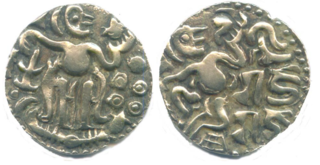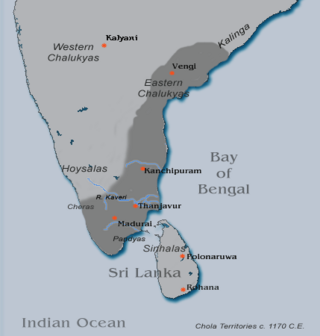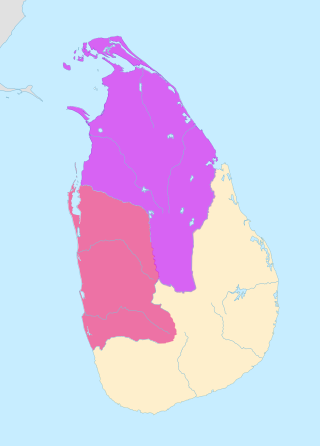
Kulottunga Chola I also spelt Kulothunga, born Rajendra Chalukya, was a Chola Emperor who reigned from 1070 to 1122 succeeding his cousin Athirajendra Chola. He also served as the Eastern Chalukya monarch from 1061 to 1118, succeeding his father Rajaraja Narendra. He is related to the Chola dynasty through his mother's side and the Eastern Chalukyas through his father's side. His mother, Ammangaidevi, was a Chola princess and the daughter of emperor Rajendra Chola I. His father was king Rajaraja Narendra of the Eastern Chalukya dynasty who was the nephew of Rajendra and maternal grandson of Rajaraja Chola I. According to historian Sailendra Nath Sen, his accession marked the beginning of a new era and ushered in a period of internal peace and benevolent administration. He was succeeded by his son Vikrama Chola

Rajadhiraja Chola I was a Chola emperor, as the successor of his father, Rajendra I. He was the only Chola emperor who was killed while leading his army in war, and although he had a short reign, he helped his father conquer several territories as well as to maintain the Chola authority over most of Sri Lanka, Eastern Chalukya and Kalinga, among others. He also established imperial relations with overseas allies despite a series of revolts in the territory.
Kalinga Magha or Gangaraja Kalinga Vijayabahu was an invader from the Kingdom of Kalinga who usurped the throne from Parakrama Pandyan II of Polonnaruwa in 1215. A massive migration followed of Sinhalese people to the south and west of Sri Lanka, and into the mountainous interior, as they attempted to escape his power. Magha was the last ruler to have his seat in the traditional northern seat of native power on the island, known as Rajarata; so comprehensive was his destruction of Sinhalese power in the north that all of the successor kingdoms to Rajarata existed primarily in the south of the island.

Rajendra Chola II often referred to as Rajendradeva Chola was a Chola emperor who reigned from 1052 CE to 1064 CE. Rajendra II succeeded his brother Rajadhiraja I after his death at the Battle of Koppam. Rajendra had served as a Co-regent under his brother from 1044 CE to 1052 CE. When he acceded the throne, the Chola Empire was at its peak stretching from Southern India to Vengai(Bengal) to parts of Southeast Asia. Rajendra had maintained the territories of his predecessor. During his reign, the Chola Empire was prosperous and had a large influence in trade throughout the Indian Ocean.

Virarajendra Chola was a Chola emperor. Son of Rajendra I, he spent a major part of his life as a subordinate to two of his elder brothers, Rajadhiraja I and Rajendra II. During his early reign, he granted the maintenance of a school to study the Vedas, Sastras and grammar. A hostel was provided for the students. A hospital named Virasolan was also provided by him for the sick people. The famous Tamil Buddhist grammatical work, Virasoliyam, was written by Buddhamitra during his reign.
Rajadhiraja Chola II reigned as the Chola king succeeding Rajaraja Chola II. He was not the direct descendant of Rajaraja Chola II, but a grandson of Vikrama Chola by his daughter. Rajaraja Chola II chose Rajadhiraja as his heir as he did not have any sons of his own.

Rajadhiraja Chola II reigned as the Chola emperor succeeding Rajaraja Chola II. Rajaraja Chola II chose Rajadhiraja II, a maternal grandson of Vikrama Chola Because he had no sons. Rajadhiraja II's father was Sangama chola who was the descendant of Virarajendra chola. Hence a century later the real Chola heir ascended the chola throne.

Kulothunga III was a Chola emperor who ruled from 1178 to 1218 CE, after succeeding his elder brother Rajadhiraja II. Kulothunga Chola III gained success in war against his traditional foes. He gained victories in war against the Hoysalas, Pandyas of Madurai, Cheras of Venad, the Sinhalese kings of Polonnaruwa, as well as the Telugu Cholas of Velanadu and Nellore. He also restored Chola control over Karur, which were ruled by the Adigaman chiefs as vassals of the Cholas. He drove out the Hoysalas under Veera Ballala II who had made inroads in the Gangavadi and adjoining areas of Tagadur in Kongu country in an effort expand their territory. However, during the last two years of his reign, he lost in war to the resurgent Pandyas, heralded a period of steady decline and ultimately, demise of the Cholas by 1280 CE. Kulottunga III had alliances with the Hoysalas. The Hoysala king Veera Ballala married a Chola queen called Cholamahadevi and gave his daughter Somaladevi in marriage to Kulottunga III.

The Chola military was the combined armed forces of the Chola Empire organized during two separate Tamil golden ages, the Sangam Period and the Medieval Era. The Chola military fought dozens of wars, and it also underwent numerous changes in structure, organization, equipment and tactics, while conserving a core of lasting Tamil traditions.

Rama Kulasekhara was the last ruler of the Chera Perumal dynasty of medieval Kerala. He was a contemporary to Chola kings Kulottunga I (1070–1120) and Vikrama Chola. Rama Kulaskehara is best known for briefly recovering Kollam-Trivandrum-Nagercoil region from the powerful Chola empire around 1100/02 AD.

Parākramabāhu I, or Parakramabahu the Great, was the king of Polonnaruwa from 1153 to 1186. He oversaw the expansion and beautification of his capital, constructed extensive irrigation systems, reorganised the country's army, reformed Buddhist practices, encouraged the arts and undertook military campaigns in South India and Burma. The adage, "Not even a drop of water that comes from the rain must flow into the ocean without being made useful to man" is one of his most famous utterances."

The Kingdom of Polonnaruwa was the Sinhalese kingdom that expanded across the island of Sri Lanka and several overseas territories, from 1070 until 1232. The kingdom started expanding its overseas authority during the reign of Parakramabahu the Great.
Lankapura Dandanatha, more commonly referred to as simply Lankapura, was a Senapati of the Sinhala Army during the reign of King Parakramabahu I. He led an expeditionary force to South India in support of the Pandyan king Parakrama Pandyan I, bringing parts of Pandya Nadu under their control. Lankapura succeeded in restoring the Pandyan prince to the throne, and ordered the use of Sri Lankan currency in areas under his and Pandyan prince control.

Tiruchirappalli is believed to be of great antiquity and has been ruled by the Early Cholas, Mutharaiyars Early Pandyas, Pallavas, Medieval Cholas, Later Cholas, Later Pandyas, Delhi Sultanate, Ma'bar Sultanate, Vijayanagar Empire, Nayak Dynasty, the Carnatic state and the British at different times. The archaeologically important town of Uraiyur which served as the capital of the Early Cholas is a Neighborhood of Tiruchirapalli.

The Chola conquest of Anuradhapura was a military invasion of the Kingdom of Anuradhapura by the Chola Empire. The period of Chola entrenchment in entire Sri Lanka lasted in total about three-quarters of a century, from roughly 993 CE to 1070 CE, when Vijayabahu I recaptured the north,east and central Sri lanka and expelled the Chola forces restoring Sinhalese sovereignty.
Parakrama Pandyan I was a Pandyan king of Tamilakkam, ruling from the Pandyan capital in Madurai. He was besieged in the Pandyan Civil War (1169–1177) by his contemporary, rival and throne claimant Kulasekhara Pandyan in 1169, a vassal of the Chola Dynasty. Parakrama Pandyan I sought assistance from the Ceylonese king Parakramabahu I of Polonnaruwa, but was subsequently executed. Kulasekhara Pandyan ascended to the Madurai throne, but was eventually forced to seek refuge in Chola country in 1171. Parakrama Pandyan I's son Vira Pandyan III ascended on the Pandyan throne before he was defeated by Chola forces.

The Pandyan Civil War from 1169 to 1177 was precipitated by rival claims of succession to the Pandyan throne. The Civil War began between Parakrama Pandyan and his nephew Kulasekhara Pandyan and lasted for the next 15 years between successive Pandyan kings. The war gradually spread to the rest of Southern India when the Chola King Rajadhiraja II and the Sinhalese King Parakramabahu I of Polonnaruwa entered the fray and took opposing sides in the conflict, eager to increase their influence in the Pandya kingdom.
The Battle of Nettur was an engagement between the Chola Emperor Kulothunga Chola III and Vira Pandya, the claimant to the Pandya throne in 1188. The subsequent crisis was erupted in the aftermath of the Pandyan Civil War, which led to the ascension of Vira Pandya.

The Polonnaruwa period was a period in the history of Sri Lanka from 1017, after the Chola conquest of Anuradhapura and when the center of administration was moved to Polonnaruwa, to the end of the Kingdom of Polonnaruwa in 1232.

Malayan invasions of Sri Lanka occurred in the mid-13th century, when the Malayan ruler Chandrabhanu Sridhamaraja of Tambralinga, invaded Sri Lanka twice during the reign of king Parakramabahu II of Dambadeniya. Both invasions were successfully repulsed by the Kingdom of Dambadeniya.












